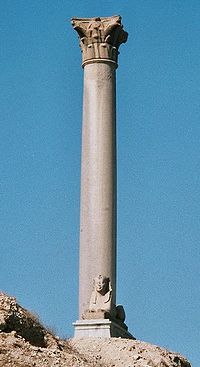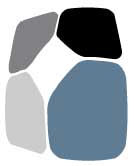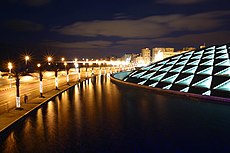About Alexandria/Attractions
When you update the content below, please add all your comments on Wikitravel too!
 Wikitravel Press has created the official Wikimania 2008 travel guide to Cairo and Alexandria. The guide is licensed under Creative Commons by-sa 1.0, and it's available for your reading and editing pleasure at the Wikitravel website: Alexandria - Cairo (including the Pyramids) - Egypt reference - Egyptian Arabic phrasebook Printed copies of the June guidebook will be distributed on site (while supplies last), but those wanting to grab a copy before the conference can buy it online (US$11.99) — new July version now available. Take a look at the Alexandria sample chapter (PDF, 6.3 MB) to see what it looks like! Any changes made now will be integrated into the next edition. You can help make it the best guide there can be! |

| Main Page | Geography | History | Attractions | Religions | Food | Stores | Media | Hotles | Museums |
Contents
- Most attractive places
- Islamic Monuments
- Christian Monuments
- Greek/Roman Monuments
Most attractive places:
Pompeii's Pillar


The Roman Theatre

The Roman theatre was shaped with a half circle or orchestra space in front of the stage. Most often the audience sat here in comfortable chairs. Occasionally, however, the actors would perform in this space. The audience was usually more interested in their favorite actors than the play itself. The actors would try to win over the audience's praise with decorative masks, costumes, dancing and mime. If the play scripted an actor's dying, a condemned man would take the place of the actor at the last moment and actually be killed on stage. The Romans loved the bloodthirsty spectacles. During the Renaissance a prominent Italian family built their home on top of the Ancient Theatre for added protection.


The Tombs of Mustafa Kamel (Rushdy)
The graveyard includes four tombs dating from the second century BC, all of which are in excellent condition and beautifully decorated. The graveyard was named after Mostafa Kamel, one of Egypt's greatest twentieth century political legends. His most famous phrase is, "If I was not born as an Egyptian, I would love to be an Egyptian.
The Catacombs of Kom al-Shoqafa

The cemetery dates back to the 1st century A.D and was used until the 4th century A.D. It was discovered in 1900 when by pure chance, a donkey drawn cart fell into a pit, which led to the discovery. The Catacombs in Alexandria are so called because the design was very similar to the Christian Catacombs in Rome. Most likely it was a private tomb, later converted to a public cemetery. It consists of 3 levels cut into the rock, a staircase, a rotunda, the triclinium or banquette hall, a vestibule, an antechamber and the burial chamber with three recesses in it; in each recess there is a sarcophagus. The Catacombs also contain a large number of Loculi or grooves cut in the rock.




The Anfushi Tombs

These limestone tombs, which date from about 250 BC, are painted to simulate alabaster and marble. They are decorated with pictures of Egyptian gods and daily life, along with graffiti, which also dates from the same period. The tomb lies to the south of the esplanade leading to the palace of "Ras el-Tin" and consists of five tombs, all dating from the first half of the 3rd century. They were discovered in 1901 and 1921. The first and most remarkable of the tombs is reached by way of a vaulted stairway hewn out of the rock, leading down into a square courtyard which is open to the sky and provides access to two tombs. The walls of the stairway and tombs have a painted stucco revetment imitating alabaster and marble. The vaulted ceiling of the funeral chamber is decorated with geometric "trompe l'oeil" designs reminiscent of the covered ceiling in certain ancient villas. The funeral motifs are an example of the combined influence of Greek art and the traditional forms of Egyptian arts.
Bibliotheca Alexandrina

the Biblioteca Alexandrina is the amazing reincarnation of the famed ancient library of Alexandria which was a great center of learning for 600 years.
The architecture of the library is modern and striking . It's outer wall made of Grey aswan granite , is carved with symbols from 120 different scripts
The main reading hall of the library is formed of 11 levels and can accommodate 2,000 readers at any one time
In the center of the library, is located a manuscript and rare book exhibition gallery in which are displayed 120 manuscripts and rare books . The library has an antiquities museum that displays the artifact discovered at the construction site of the modern library.
Next to the main library building , there is a hung planet-like sphere which is the " Planetarium center " It's aim is to establish a scientific culture through a collection of scientific show overing different ages and backgrounds the planetarium's theater comprise 100 seats that are arranged in a way to give the audience a comfortable view of the 360 degree surrounding
Islamic Monuments:
the Attarine Mosque - Alexandria
The Attarine district is considered to be one of the most interesting areas in Alexandria. It is a sprawling antiques district. There are antique shops piled high with European furniture
The Attarine Mosque is located in the middle of this unique area, on Attarine Mosque Street. This mosque was originally a church dedicated to Saint Athanasius in 370 AD. When Islam came to Egypt, the church was converted into a small mosque, which was built up and eventually became known as the Mosque of a Thousand Columns. As time passed, this mosque started to get old and some of its ceilings were damaged at the beginning of the Fatimid period.
Fort Qaitbey(The Citadel of Qaitbey)-Alexandria
Fort Qaitbey is a great tourist site for kids. Kids grow up playing fort, and visiting this destination is really a wonderful experience for the whole family. It is one of the main tourist attractions of Alexandria and really one of the icons of the city. It is a beautiful location, overlooking and with a great view of the Mediterranean Sea and of Alexandria as well. The fortress itself has the look of a storybook castle, where the imagination of particularly the young can spiral into dreams of a more romantic age, of coastal sea battles between French and English ships and even pirates. The entrance fees for the fortress are two pounds LE for Egyptians and twelve LE for foreigners
The Mosque of Abu al-Abbas al-Mursi - Alexandria
This beautiful mosque, with its high minaret and four domes, is Alexandria's largest and one of the most important Islamic monuments. In 1775 the Algerians built the mosque over the tomb of the thirteenth century Andalusan saint Ahmed Abu al-Abbas al-Mursi who had joined and then lead the Shadhali brotherhood. The interior is made up of eight monolithic granite columns and a colonnade of elongated arches. It was rebuilt in 1943 with the domes and the towering (73 meter) minaret. It is one of Alexandria's foremost religious buildings and women are not allowed inside the mosque proper, but may only visit a room at the back of the mosque.
The Tombs of Mustafa Kamel (Rushdy)
The Muntazah Complex – Alexandria]]
This 115 acre complex is surrounded by great walls from the south, east and west, and with the beach on its north side. This area used to belong to the Mohamed Ali family, that ruled Egypt from the mid 19th century until 1952. The construction was started in 1892 by King Abbas II, who built a large palace inside the complex called the Salamlek. In 1932, King Fuad built a larger palace and called it the Haramlik. His son, King Farouk, built a bridge to the sea to act as a water front. The rest of the 115 acres is nothing but beautiful gardens. Palm trees and gazelles cover the area. This is a wonderful spot to enjoy the beauty of Alexandria.
The Shatby Tomb - Alexandria
The tomb dates from the third century BC and was patterned after an old Greek house with an entrance, a front room, and a back room. It is very similar to the ones found in the Anfushi district, and is considered to be Alexandria's oldest tomb.
Terbana Mosque - Alexandria
Built in 1677, Terbana Mosque is one of the few remaining ancient mosques in Alexandria. It is located at the corner of Terbana street and Suq el-Tabakheen Street. The entrance of the mosque is a portal of bicolor bricks. A visitor can see two enormous granite columns with Corinthian capitals, and there are a number of ancient columns that are scattered inside the mosque. The mehrab, a corner in the mosque which shows prayers directions to Mecca, is covered with North African style ceramics.
Christian Monuments:
The St. Marcos Church - Alexandria
This church reputedly was established by St. Mark the Evangelist who brought Christianity to Egypt. The current church is built on the remains of an earlier church and is in the basilican style. The church has a large hall that leads to the 11th century cemetery of Coptic archbishops.
The Tegran Necropolis - Alexandria
The necropolis is located west of Alexandria in the Wardian district. The tomb is dated to the 2nd century BC and was built for a rich man in Alexandria during the Roman era. The decoration of the tomb is influenced by the ancient Egyptian motifs of funerary art. In the tomb is a mural of a mummified corpse that was laid on a bier and a figure of two mourners connected with the goddesses Nephthys and Isis. On the top of the bier is the winged sun-disk.
Greek/Roman Monuments:
The Anfushi Tombs
The Amphitheater
The amphitheater consists of thirteen gray and white marble levels of terraces that lead down to the arena. Its buttressed wall was designed in a semicircular style to act as a passageway that ran beneath the early theater. Not far away from the theater are some ruins of the Roman baths.
Caesareum
Nothing remains of the Temple of Augustus. Founded by Cleopatra in honor of Mark Antony, it may well be in this temple that Cleopatra committed suicide in 30 BC. The temple stood near the shore at the center of the great harbor. It was a lavish temple with porticoes, propylalea, parks and libraries. The temple was rededicated to Caesar Augustus, Mark Antonio's conqueror. With the adoption of Christianity, it became the Cathedral of Alexandria in the 4th century AD. It was destroyed in 912 AD. In front of the temple stood two red granite obelisks called "Cleopatra's Needles", though they bear the names of Tuthmosis III, Seti I and Ramesses II. The obelisks were brought to Alexandria from Heliopolis by the Romans 20 years after Cleopatra's death. These giant Obelisks stayed still facing the old Harbor until 1877, when the British forces took them and shipped them away. One was removed to the Thames Embankment in London, and the other was taken to New York where it stands in Central Park. The statue of a great Alexandrine Nationalist called Saad Zaghloul is standing in the same location where Caesareum used to be. The statue is surrounded with a park which is considered to be one of the busiest squares in Alexandria.
The Catacombs of Kom al-Shoqafa
Pompeii's Pillar
The Roman Theatre
The Temple of Taposiris Magna
The temple was built in the Ptolemy era and finished the construction of Alexandria. The temple is located in Abusir, the western suburb of Alexandria. The temple was dedicated to Osiris. Only the outer wall and the pylons remain from the temple. There is evidence to prove that sacred animals were worshipped there. Archeologists found an animal necropolis near the temple. Remains of a Christian church show that the temple was used as a church in later centuries. Also found in the same area are remains of public baths built by the emperor Justinian, a seawall, quays and a bridge. Near the beach side of the area, we can see the remains of a tower built by Ptolemy II Philadelphus. The tower was an exact scale replica of the destroyed Alexandrine Pharos Lighthouse.
Underwater exploration in the Alexandria Harbor
Over its long history, Alexandria has been the cradle of several civilizations of the ancient world; Pharaonic, Hellenistic and Roman. This multicultural museum lies safely under Alexandria’s Mediterranean coastal waters, that, during the Fifth Century B.C. formed part of the ancient city of Alexandria and was devastated by earthquakes and tidal erosion. In view of the lack of scientifically verified information of a relatively obscure epoch of Egyptian history, a project was initiated in 1992 by the Supreme Council for Antiquities, in cooperation with the European Institute of Submerged Antiquities, to make a topographic survey of the area of royal facilities at the submerged parts, specifically the Eastern Port, which commands a major historical importance. Exploratory operations resulted in the following: An overall topographic picture of the submerged royal quarter in ancient Alexandria. A number of 1300 sites were located at sight and cleared of attaching sediments. Six archaeological maps were drawn up, showing accurately the topography of several areas of major historical significance. These operations have allowed a full panorama of the reputed Magnus Portus. Major discoveries then followed as landmarks of the isles of Pharos (referred to in Homer’s Odyssey (7th Century B.C.) and Interodos started to unfold, with their royal palaces, statues and decorations. Several antiquities such as two statues of the Sphinx, of which one is made of grey granite and the other of durite, were broken up as a result of natural disasters. These structures are indicative of the dense constructions along the eastern coastline. These discoveries made over the years 1996, 1997 and 1998 have given impetus to further explorations of the seaport basin and the fathoming of depths.